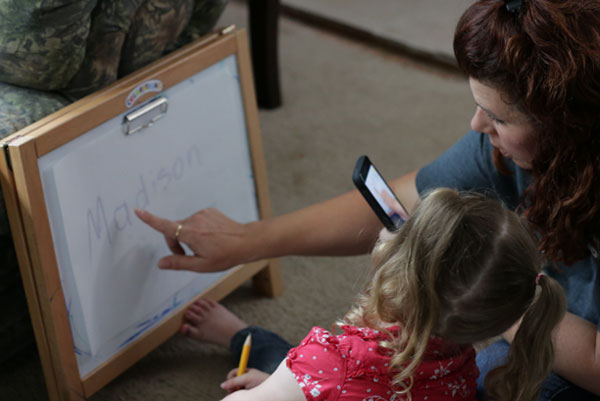Reflections
What do you observe Isaiah doing?
Answers may include:
- Isaiah opens and closes the egg carton, then shakes it.
- Isaiah gets an object out of "his" drawer and puts it in the egg carton.
- The three adults are shaking and swaying scarves; Isaiah has a scarf around his neck that he is holding.
- When his father is putting Isaiah's sock on, Isaiah repeats "blue sock" after his father says it.
- Isaiah's mother is playing with the egg carton with him and putting blocks into it. Isaiah says, "I do it."
- Isaiah is holding a bag with a zipper. His mother asks if he can zip the zipper. He says something and hands it to his mother. She tells him to hold it, and together they pull the zipper.
- Isaiah rubs a rattle on his head with two hands.
- Isaiah runs and pumps one arm as he runs.
What do you observe that focuses on enhancing Isaiah's knowledge?
Answers may include:
- The family is working on counting.
- The home visitor suggests using an egg carton to count the treasures in the child's drawer.
- The egg carton will allow for sorting as well as counting, which adds another dimension to Isaiah's learning.
How can you apply these principles to working with families in your program?
Answers may include:
- Use materials the child is already interested and expand their use or add additional materials for new experiences.
- Use materials from the home in creative ways to enhance the child's cognition and general knowledge.
- Use daily routines to help children learn, such as matching socks in the laundry and noticing one-to-one correspondence while helping to set the table.
Reflect on ways you can use materials and routines in your families' homes to enhance the child's cognition and general knowledge.
Answers may include:
- Are there routines or materials related to their culture that you might follow up on to enhance the child's cognitive experiences?
- Use aspects such as fishing, drumming, chanting, singing, simple poems, or finger plays from the family's culture to plan rhythm, simple math, or social studies experiences.
- Do you use everyday materials in your home visits to enhance the child's knowledge and skills?
- How can you enhance what infants, toddlers, and 2-year-olds already know to extend their learning?
- Individual reflection
In what other developmental domains did you observe Isaiah and his family engage?
Answers may include:
- Perceptual, Motor, and Physical Development
- Isaiah used fine motor skills and eye-hand coordination to put objects in the egg carton
- Isaiah ran using his arms and legs
- Language and Literacy
- Isaiah conversed with his mother and father (e.g., "I do it," something like "I need help," "blue sock")
- Repetition
- Isaiah's father said words and he repeated them
- Approaches to Learning
- Exploring
- Isaiah put "treasures" in the egg carton, then lifted it up and shook it
- Experimentation
- Isaiah wanted to try things himself
- Self-regulation
- Isaiah was able to ask for help when he needed it
- Exploring
- Social and Emotional Development
- Self-confidence and Independence
- Isaiah wanted to try things himself and his mother supported it
- Asking for Help
- Isaiah was able to ask for help and his mother provided it, but supported his emerging ability to do it himself
- Isaiah sat on his mother's lap
- They both smiled
- Self-confidence and Independence
News You Can Use: Supporting Early Math Learning for Infants and Toddlers
Infants and toddlers develop and refine math concepts and skills through everyday routines, experiences, and most important, caring interactions with trusted adults. Teachers, home visitors, family child care providers, and families all have an important role to play. Explore ways adults can be more intentional in how they support young children's math learning and school readiness.
Gopnik, Alison, Andrew N. Meltzoff, and Patricia K. Kuhl. The Scientist in the Crib: What Early Learning Tells Us About the Mind. New York: Harper Perennial, 2001.

 Cognition refers to young children's increasing abilities to learn. Young children gain information from their physical environments (e.g., home, neighborhood, and community) and their social environments (e.g., interactions with important adults, experiences they have, and the culture around them). The ELOF provides a detailed progression of the knowledge and skills a child achieves in these domains.
Cognition refers to young children's increasing abilities to learn. Young children gain information from their physical environments (e.g., home, neighborhood, and community) and their social environments (e.g., interactions with important adults, experiences they have, and the culture around them). The ELOF provides a detailed progression of the knowledge and skills a child achieves in these domains.